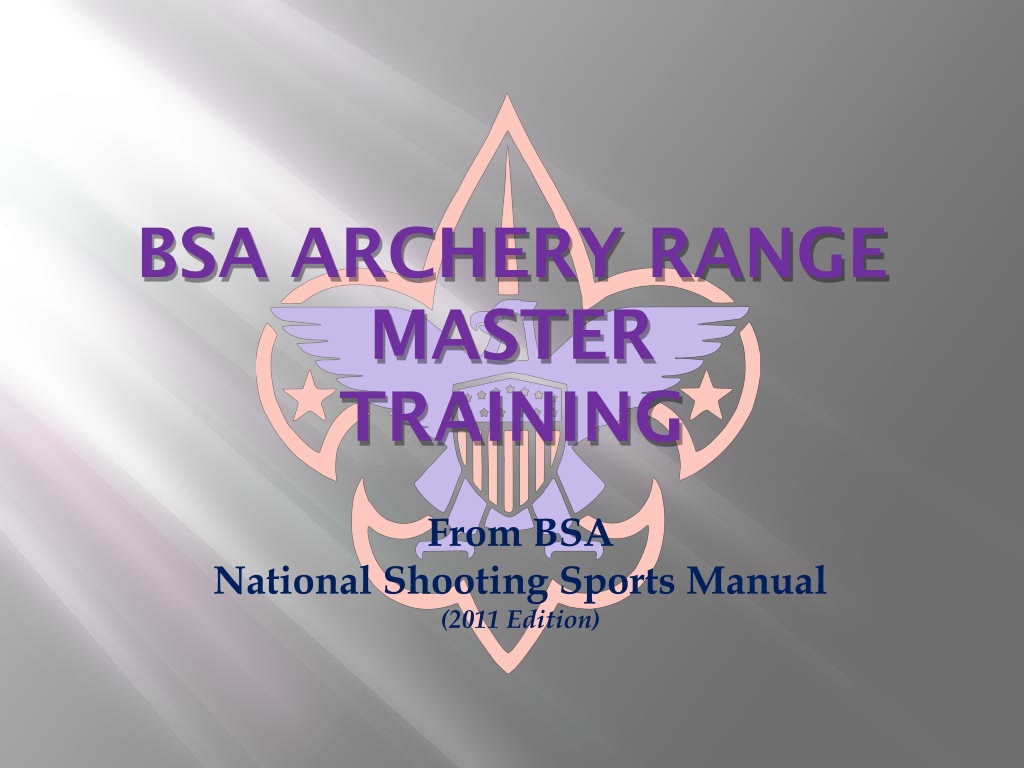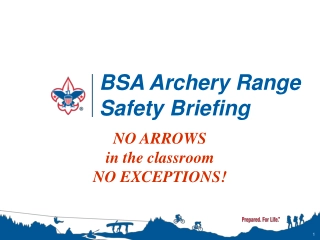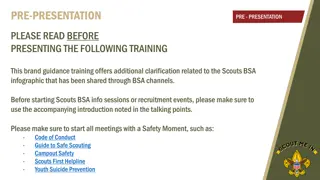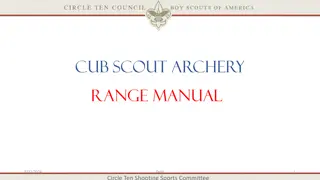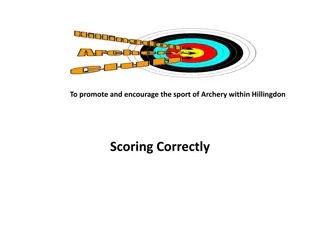BSA Archery Range Master Training Manual
Explore the comprehensive BSA National Shooting Sports Manual for Archery Range Master Training. This manual covers a range of topics including the history of archery, safety guidelines, equipment review, range layout, shooting basics, targets, scoring, whistle codes, and more. Get insights into the essential skills and knowledge required to become a proficient archery range master. Enhance your understanding of archery practices and procedures with this detailed training resource.
Download Presentation

Please find below an Image/Link to download the presentation.
The content on the website is provided AS IS for your information and personal use only. It may not be sold, licensed, or shared on other websites without obtaining consent from the author.If you encounter any issues during the download, it is possible that the publisher has removed the file from their server.
You are allowed to download the files provided on this website for personal or commercial use, subject to the condition that they are used lawfully. All files are the property of their respective owners.
The content on the website is provided AS IS for your information and personal use only. It may not be sold, licensed, or shared on other websites without obtaining consent from the author.
E N D
Presentation Transcript
BSA ARCHERY RANGE MASTER TRAINING From BSA National Shooting Sports Manual (2011 Edition)
INTRODUCTION Welcome Instructors Facilities Course
TRAINING ARCHERY RANGE MASTERS This presentation is from the BSA National Shooting Sports Manual. A special Thanks goes out to the Task Force and NRA for this manual.
TRAINING ARCHERY RANGE MASTERS Class Notes All of the course material is on the class CD. Deviations from the manual are proceeded by NOTES If you are an Instructor and wish to change this Power Point presentation please use the newest version software.
TRAINING ARCHERY RANGE MASTERS Section I (40 minutes) A. A Brief History of Archery B. Safety Guidelines 1. Sun Safety on the Shooting Range
TRAINING ARCHERY RANGE MASTERS Section I Continued C. Equipment 1. Review bows, bowstrings, arrows, arm guards, finger tabs, quivers, points of aim, target butts, target faces, and backstops. 2. Review how to string and unstring a bow, and have the participants demonstrate this. 3. Review how to maintain, store, and care for equipment.
TRAINING ARCHERY RANGE MASTERS Section I Continued D. Range Layout, page 79 This procedure is to be taught on the archery range. Review range layout, safety fencing, backstop, entryway, range flag, target spacing, waiting line, shooting line, and bow racks and quivers. E. Range Operation Rules
TRAINING ARCHERY RANGE MASTERS Archery Shooting Basics 1. Eye Dominance 2. Stance 3. Nock the Arrow 4. Establish the Bow Hold 5. Draw 6. Aim, 7. Anchor 8. Release or Loose 9. Follow Through 10. Retrieve Arrows Section II (40 minutes) B. Targets and Scoring 1. Target Butts 2. Target Faces 3. Backstops C. Know the Proper Whistle Codes D. Archery Practice Fun
TRAINING ARCHERY RANGE MASTERS Section III (20 minutes) A. Training Cub Scouts 1. Teaching Tips B. Shooting a Competitive Round C. Archery Games and Activities D. Tiger Cubs and Archery E. Cub Scout Shooting Sports Award F. Archery Belt Loop and Sports Pin
ARCHERY HISTORY Spearheads - many thousands of years ago. 6000 B.C. Early bow of yew or elm. Provided a much safer way to hunt and made life easier. 3500 B.C. to 2800 B.C. Egyptians first battle use. Composite bows - about this same time period. 1500 B.C. Assyrians developed a shorter recurve bow that provided more power and easier handling.
ARCHERY HISTORY Crossbows were also used in ancient China. About this same time, the Parthians became famous for shooting backwards while riding a horse. Around 1200 B.C. Egyptian pharaoh Rameses II put archers on chariots. This mobility allowed the Egyptians to defeat the Hittite army. Around 1000 A.D. Archery was adopted by native Americans. The British were famous for improving on the bow, which eventually became known as the British longbow.
ARCHERY HISTORY 1346 Famous battle of the longbow at Crecy. 1500, crossbows were banned in England to promote the use of the longbow. 1595, the army was ordered to replace all bows with muskets. Archery has remained a popular sport in England. Some of the first archery clubs were formed in England.. Competitions were part of their way of life.
ARCHERY HISTORY 1879 the National Archery Association was founded and the first national tournament was held in White Stocking Park in Chicago. 1928 First US archery club, United Bowmen of Philadelphia. 1900 archery became part of the Olympics and dropped in 1920 because rules not standard. 1931 FITA was founded in Paris and standardized the rules for international competition. 1972 Archery re joined the Olympic program.
SAFETY GUIDELINES Tiger Cubs with their adult partners, Cub Scouts, and Webelos Scouts should learn these simple safety rules. When training youth to shoot, be sure to have the proper equipment, secure and safe ranges, and clear safety instruction.
SAFETY GUIDELINES (CONT.) 1. Observe all state and local laws on using a bow and arrow. 2. Shoot only with proper range supervision. 3. Always check your equipment before shooting. Break and discard all cracked or fractured arrows. 4. Be sure to include all of the safety guidelines and the proper whistle codes. 5. Bows and arrows should be used only in places set aside for their use. 6. Always keep your arrows pointed down or toward the target.
SAFETY GUIDELINES (CONT.) 7. Only release an arrow when you can see its full clear path to the target. 8. Shoot only at the target in front of you. 9. Keep the arrows in the quiver until everyone is on or behind the shooting line and the Range Master has indicated that you may begin shooting. 10. Shoot with your feet behind the shooting (firing) line. 11. Stop shooting immediately upon signal from the Range Master or if anyone crosses in front of the shooting line or in front of or behind the targets.
SAFETY GUIDELINES (CONT.) 12. Use only arrows that have been measured for your proper draw length. Arrows that are too short may cause personal injury or damage to the bow and arrow. 13. Always wear an arm guard and finger tab or glove. 14. Always practice courtesy and good sportsmanship. 15. Always walk, never run, when on the archery range or while carrying arrows. 16. On a target range, leave the bow standing against the target face while you are looking for lost arrows. 17. Stay on marked paths. Travel the direction in which the targets are marked.
SUN SAFETY Limit exposure to sun between 10 a.m. and 4 p.m. when the sun s rays are the strongest. Generously apply sunscreen with a sun protection factor (SPF) of at least 15 and reapply it every two hours when outdoors, even on cloudy days. Wear protective, tightly woven clothing, such as a long sleeved shirt and pants. Wear a hat with a wide, 4-inch brim and sunglasses with UV protective lenses. Stay in the shade whenever possible. Avoid reflective surfaces, which can reflect up to 85 percent of the sun s damaging rays.
EQUIPMENT TOPICS Bows Bowstrings Arrows Arm guards Finger tabs, Quivers, Target butts, Target faces Backstops
EQUIPMENT Storage When not in use, archery equipment should be kept in locked storage to protect it from weather, rodents, and theft. For instructions on how to build storage lockers and other storage equipment see pages 103 106.
EQUIPMENT (CONT.) Archery Equipment for 100 Campers Six 48-inch target faces mounted on straw target butts and tripods or on stacked, baled straw 10 bows four 15-pound, four 20-pound, and two 25-pound 12 bowstrings 12 finger tabs 12 arm guards 60 arrows selected to fit bows 36 action archery arrows Two sets of field archery targets 60 plastic jugs (various sizes) 12 ground quivers (camp-made)
EQUIPMENT (CONT.) BOWS In General - Recurve preferred for beginners easier to learn finger tension lighter wood, fiberglass or composite Compound shorter, some adjustments
EQUIPMENT (CONT.) BOWS In General Fiberglass Lighter Less expensive Less care
EQUIPMENT (CONT.) Basic Bow Care Never lay a bow on the ground. Never stand a bow on end. Store bows by laying them on pegs that support the bow in the handle riser section. Although finishes are waterproof, it is best to dry the bow if it gets wet.
EQUIPMENT (CONT.) Basic Bow Care Continued Carry a bow unbraced in a bow case to protect it from scratches and possible damage. Never leave a bow in an automobile as the heat may cause damage. Store bows unstrung and, if possible, in a cool place with moderate humidity.
EQUIPMENT (CONT.) BOWSTRINGS Dacron Serving of multi fillament nylon Keep waxed Inspect daily Repair or replace Order new string by pull and length
EQUIPMENT (CONT.) BOW STRINGER Push Pull or Step Through can damage recurves Demonstration by Instructor Store recurves unstrung
EQUIPMENT (CONT.) Arrows Arrows of Port Orford cedar, pine, birch, aluminum, or fiberglass are suitable for beginners. Wood arrows are the least expensive, but aluminum and fiberglass arrows are more durable and will last much longer.
EQUIPMENT (CONT.) Arrow Measuring Draw your bow using an extra long arrow to your normal full draw. Have someone mark the arrow shaft at least one inch directly in front of the spot where the arrow contacts the most forward position of the arrow rest. Beginners may want to add one to two inches.
EQUIPMENT (CONT.) AVERAGE ARROW Adult male uses a 28-inch arrow. Adult female uses a 26-inch arrow. Teenager uses a 26-inch arrow. Youth 12 years old or younger uses a 24-inch arrow.
EQUIPMENT (CONT.) CARE OF ARROWS If the feathers become wet, wipe them dry and clean before storing. Separate the arrows until they are dry to allow the feathers to regain their original shape. Discard any fiberglass or wooden arrows that have splinters or cracks in the shaft.
EQUIPMENT (CONT.) CARE OF ARROWS Continued The arrows can be kept in the quivers during the season. Long term storage in original boxes with individual holes for each arrow. This will preserve the feathers and help prevent wooden arrows from warping.
EQUIPMENT (CONT.) ARM GUARDS The arm guard is either leather or plastic with at least two elastic straps. It is slipped over the forearm that holds the bow and provides protection from the slap of the bowstring after the arrow is released. Keep arm guards clean.
EQUIPMENT (CONT.) Finger Tabs Finger tabs are preferable to gloves for group instruction because they present fewer fitting problems. Made of smooth leather, finger tabs absorb the friction of the bowstring across the fingertips. Without them, painful blisters can develop. Many designs are available, but for beginners the simplest and most inexpensive type is satisfactory.
EQUIPMENT (CONT.) Quivers For the young beginner, having a quiver to use when returning arrows from the target to the shooting line will improve safety procedures.
EQUIPMENT (CONT.) REVIEW Review bows, bowstrings, arrows, arm guards, finger tabs, quivers, points of aim, target butts, target faces, and backstops. Review how to string and unstring a bow. Review how to maintain, store, and care for equipment.
RANGE LAYOUT Safety is a primary concern when operating an archery range, and the safety rules must be followed. If at all possible, the range should be laid out so shooting is done in a northerly direction. To protect arrows, all outcropping rocks should be removed. Keep grass cut close and raked clear. Sandy soils need no ground cover. Important! Arrange facilities so there is no possibility of non-participants inadvertently walking behind the targets while shooting is in progress!
RANGE LAYOUT TYPICAL RANGE
RANGE LAYOUT TYPICAL RANGE NOTE Know your equipment. Know the range of your equipment and shots. The arrows must be contained on the range.
RANGE OPERATION RULES Know the Proper Whistle Codes Two blasts. Move up to the firing line. One blast. Fire the proper number of arrows. Three blasts. Cease firing. Move to the target. Retrieve and score arrows. Four or more blasts. Cease firing. Stay where you are. This is an EMERGENCY. Officials will tell the archers what action to take either verbally or by the whistle code.
RANGE OPERATION RULES Know the Proper Whistle Codes Remember there is only ONE command to shoot ONE blast of the whistle. For any command of more than one blast, STOP shooting. Watch and listen for further instructions.
RANGE OPERATIONS RULES Sample Range Rules Poster Archery Range Rules 1. This range may be opened only by a certified archery Range Master. All commands issued by the Range Master must be obeyed immediately. Stay behind the firing line. Do not straddle the firing line. Do not reach for objects that fall beyond the firing line. Bows will be placed on ground quivers when shooting has ceased or when retrieving arrows. No bows may be carried to the target butts. Do not pick up a bow or nock an arrow unless told to by the Range Master. Absolutely no running on the range. Belt quivers should be used while retrieving arrows. No horseplay or unnecessary talking on the range. If in doubt about these rules, ask your leader or Range Master for advice and help. 2. 3. 4. 5. 6. 7. 8.
BREAK Ten Minutes
ARCHERY SHOOTING BASICS Archery Shooting Basics The following instructions are written for right-handed shooters. When training left-handed shooters, reverse the instructions as necessary.
